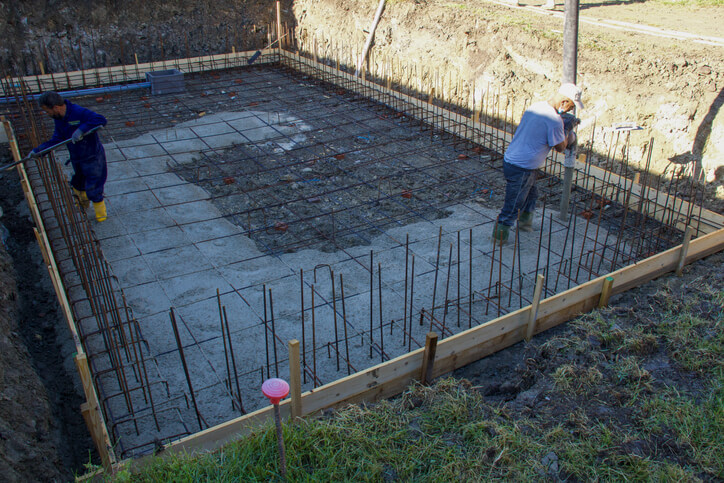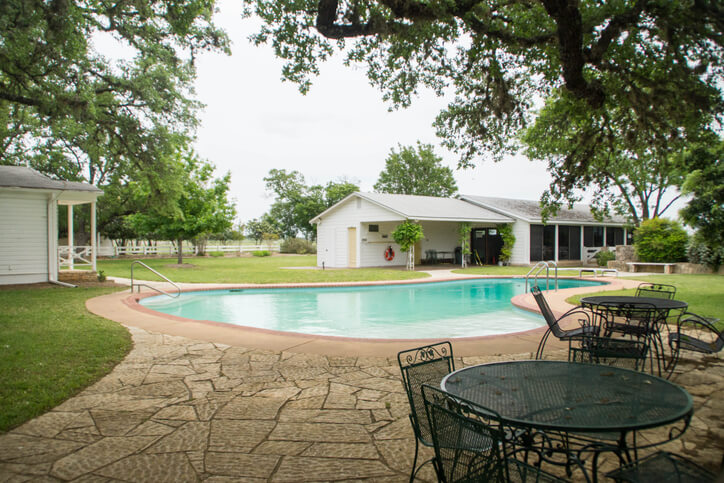Having a swimming pool in the garden is a real luxury, especially when summer arrives and, with it, the heat and high temperatures. Not only is it the element you need to cool off in the sun, but it also becomes a place of fun and games for the little ones in the house. They won’t want to be anywhere else!
If you want to build a swimming pool, we already tell you that it is not an easy task. It is a major project that requires a significant investment of time and money. However, there are many reasons why it is worth embarking on this adventure. Discover them!
In-ground swimming pool: characteristics and types
Do you want to enjoy a swimming pool at home this summer? Then our advice is that you do not delay any longer and start looking for professionals to build the swimming pool you dream of.
There are different types of swimming pools, although they can be divided into two main groups: above-ground and in-ground .
- Above ground pools: they are built on the ground, without the need to excavate for the pool tank. They are faster and easier to build and, therefore, more economical.
- Inground pools: they require a major work and a higher investment, but they are more durable and resistant. If you want a pool to enjoy for many years, this is the best option.
Is it worth building a swimming pool?
If you are wondering whether an in-ground pool has real advantages over a prefabricated one, the answer will depend on how you are going to use the pool in the future. In the case that you really use it very frequently, then in-ground pools will be a good choice.
- They are more resistant than prefabricated ones and, therefore, more durable.
- You can choose the design, the size, the depth, the shape, the materials for the finishing, etc. You decide all these aspects that, in prefabricated pools, are already determined.
- A swimming pool alwaysadds value to the house. It is a way to revalue it for the future.
Pool construction planning tips
The first thing to think about when building an in-ground pool is who is going to use it and for what purpose. Do you need a pool for swimming? Do you want it for the whole family to enjoy in summer? Do you want it for the children to play in? Having this in mind is important when planning the design, shape and size of the in-ground pool.
In addition, you should take into account these tips for your approach:
- If you want to enjoy your new pool in summer you will have to start building it in winter, since the process will take several weeks. In addition, during the winter months it is easier to find specialized companies to take care of the work, since in summer the work of these professionals is multiplied.
- Before starting work, it is necessary to obtain the municipal building permit, so you will have to submit a technical project of the pool at the town hall of your municipality.
- To decide the dimensions of the pool, you must take into account the available space. As for the depth, it usually ranges between 1 and 1.70 m. Think that the bigger and deeper a pool is, the higher the consumption of water and chemical products will be.
- Before choosing the location where to place the pool, remember that the ground must be flat, without trees nearby (they dirty the water and sometimes the roots can cause problems) and should not be too close to the house. It is also important that it is safe from prying eyes.
- In general, and whenever possible, the pool should be oriented to the south, since it will have more hours of sun per day.
How to build a swimming pool
The construction of a swimming pool includes different phases and processes that you must be clear about from the beginning, even if the work is carried out by professionals.
Swimming pool design phase
Before starting work in the field you must have chosen the shape (rectangular, round, square or kidney), the size, the filtration system, whether you are going to illuminate the pool or not, etc.
Excavation phase
The first thing to do is to mark the perimeter of the pool on the ground with a line on the ground drawn with plaster. Then, all the soil is extracted with a backhoe or with the appropriate machinery in each case. It is important to dig about 30 cm more than the depth that the pool should have, as well as on the sides, thinking about the thickness that the concrete and the liner will have.
Construction phase
The first step in this stage of the process is to flatten the ground to make it uniform. Sometimes it has to be filled with aggregates and compacted to make it firm. Then a grid formed with metal rods is placed on the floor and walls, which gives greater strength to the concrete and thus reinforces the pool shell.
The next step is to pour the concrete for the floor while it is flattened and spread on the bottom. This layer should be approximately 10 cm thick. A waterproofing agent should be added to the concrete to prevent leaks.

Plumbing and electrical work
It consists of installing the piping for the pool water inlet, pumping and outlet. It is also the time to install the electrical system for the pool lighting.
Wall construction phase
It is time to build the walls of the pool. They can be made with concrete blocks, bricks or by concreting. For that you have to place a formwork and pour the concrete.
Waterproofing phase
One way to prevent water leaks in the future is to apply a waterproofing mortar to the inside of the pool. To do this, the interior plaster must be allowed to dry completely. It must also be smooth, without irregularities. The waterproofing mortar is applied by roller, following the manufacturer’s instructions as to the number of coats and the time to wait between coats.
Installation of the sewage treatment plant
A buried space is usually built to locate the water treatment plant, a few meters from the pool, which can be accessed through a trap door, or you can also build a shed to install the machinery that will be responsible for cleaning the water, a system of filters, pumps, valves and other devices that must be well protected.
Coating phase
It consists of lining the inside of the pool with the appropriate material:
- On gresite is a good choice for the interior of the pool, available in a variety of designs and colors. Choose a model with a non-slip finish to prevent falls and slips.
- The porcelain tile is even more resistant for the interior. It withstands impacts and humidity and is not affected by sudden changes in temperature. In addition, there is a wide variety of designs to unify the interior and exterior of the glass.
- Another option is to paint the interior with a specific paint. Although it is the easiest and cheapest alternative, you should know that you will have to renew the paint every two or three years.
- The outdoor area can be made of wood, porcelain, cement, grass, etc.
- At the edge of the pool it is important to install a non-slip material such as precast concrete, and to avoid sharp edges and corners.
Technical details of a swimming pool
When building an in-ground pool, it is key to choose an efficient filtration system, with sand, cartridge or diatomaceous earth being the most common, each with different levels of maintenance and efficiency.
For air conditioning, heat pumps, solar panels or heat exchangers can be installed, optimizing energy consumption. Submersible LED lighting improves aesthetics and reduces electricity costs.
In addition, automation systems make it possible to control temperature, pH and filtration from a cell phone, facilitating maintenance. Finally, it is important to select a suitable coating such as gresite, reinforced sheet or microcement, according to the desired durability and aesthetics.
Legal regulations
When planning the construction of a private swimming pool in Spain or anywhere else, it is essential to comply with current legal regulations to ensure the safety and legality of the installation.
First, an urban planning license must be obtained, in addition to a building permit issued by the corresponding city council, by submitting a technical project prepared by a qualified professional that complies with the Technical Building Code (CTE).
It is also important to comply with safety and construction standards, such as the installation of adequate purification systems and the maintenance of water quality.
Finally, it is advisable to consult the regional and municipal regulations, as there may be additional requirements depending on the location of the property. Complying with these regulations not only ensures the legality of the pool, but also guarantees the safety and well-being of its users.
I want to build a swimming pool, how much can it cost?

Apart from knowing how to build a swimming pool, it is also important for you to know that it is not cheap. Rather, on the contrary, it is a project that requires a considerable investment. However, and although the budget depends on many factors such as the size of the pool or the materials used, we can give an approximate figure. The average size models range from 10,000 to 16,000 euros. For example, an in-ground swimming pool of 7X3 m and 1.5 m deep is around 15,000 euros.
Your dream pool, within your reach
You already know everything you need to build a swimming pool, from the initial approach to the design and execution phases. If you have any other questions, just ask our experts at Paratureforma, without any obligation. This summer, the best dips will be at home!
How much does it cost to build a swimming pool?
The price varies according to size, materials and extras, but usually ranges between 10,000 and 30,000 euros, depending on depth, finishes and filtration systems.
How long does it take to build a swimming pool?
Construction time depends on the method and weather conditions, but on average it takes between 4 and 8 weeks, including excavation, structure, waterproofing and installations.
What permits do I need to build a swimming pool at home?
Generally, a building permit from the city council, a technical project signed by an architect and compliance with safety and drainage regulations are required.
What is the best filtration system for an in-ground pool?
The most common are sand filters (efficient and low maintenance), cartridge (economical but require more cleaning) and diatomaceous earth (maximum filtration but higher cost).
How to keep the water in a swimming pool in good condition?
It is essential to have a chemical balance with chlorine or bromine, an efficient filtering system, periodic cleaning of waste and, in winter, the use of covers to avoid dirt.



